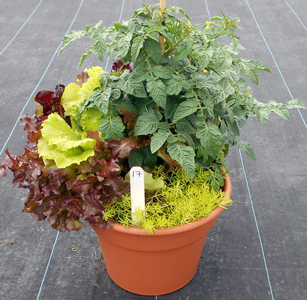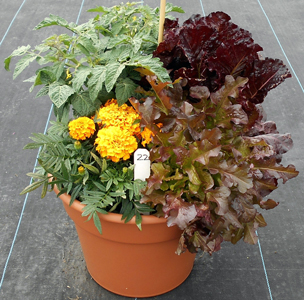12/31/2015
Combos That Are Pretty & Tasty
Kendra Hutchins, Bill Miller, Neil Mattson & Cheni Filios

Small gardens are big! From Millennials to aging Boomers, consumers are turning more and more to gardens that can thrive in small spaces with minimal care. They’re also increasingly interested in growing their own food; edibles are most definitely “in.” With interest in small-scale, multi-functional gardens continuing to grow, we decided to experiment with mixed vegetable, herb and ornamental containers. Partnering with Cheni Filios from PanAmerican Seed, we put together several dozen large (14-in.) containers and presented them at Cornell University’s annual Floriculture Field Day on August 11. PanAmerican Seed donated most of the vegetable and herb varieties. Ornamentals were selected from among the varieties submitted for our annual trials or from donations by Baker’s Acres and Dickman Farms in upstate New York.
Pictuted: Tidy Treats Tomato
Sedum rupestre Lemon Coral
SimplySalad Summer Picnic
Culture
We tried to keep our protocol as simple as possible. Vegetables and herbs were sown in 200- and 72-cell plug trays, respectively, on March 25, 2015. They were transplanted to 4-in. containers on April 22 and then into the final 14-in. containers on May 20.
Lettuce mixes were sown in 72 plug trays on April 22, then directly transplanted into 14-in. containers on May 20 along with the vegetables and herbs. A professional peat/perlite potting mix (Lambert LM-111) was used in all 4- and 14-in. containers. All plants were grown in the greenhouse until they were transplanted into the 14-in. containers, at which time they were moved outside.
In the greenhouse, seedlings received a standard fertilizer regime of Jack’s 21-5-20 at 100 ppm N plus Epsom salts (magnesium sulfate) at 30 ppm Mg twice weekly. Since we wanted our final product to be edible, pests were controlled with biocontrols only. Once moved outside, they received Jack’s 15-5-15 Cal/Mag once per week at a rate of 750 ppm N throughout the summer. This rate was chosen to mimic what a consumer would provide if using about 1 tbsp. of fertilizer per gallon of water once per week.
 Results
Results
The results were even better than we had hoped; many of these combination planters were simply stunning. The containers were not only beautiful, with bright splashes of color and texture, but also produced bumper crops of fresh vegetables: tomato, pepper and eggplant harvests were abundant. Feedback from our growers at the field day was positive, too. The containers generated a buzz, with many favorable comments regarding their novelty and functionality.
Pictured: Tidy Treats Tomato
Marigold Taishan Orange
SimplySalad Summer Picnic
One thing we learned from this trial is that not every combination works perfectly. Some combinations were unsuccessful, with one component overpowering the others as the trio matured. For vegetables, dwarf determinate tomatoes and patio varieties of other vegetables seem to be the best bet. Some vegetables have a shorter container life than others. These plants can be removed after harvesting to let the other varieties continue to show off.
Having seen the results of this trial—the good, the bad and the just plain ugly—we look forward to further experiments with vegetable, herb and ornamental combinations in the coming year. Stay tuned for future tips for successful mixed vegetable and ornamental container gardening!
For more photos of our mixed containers, please visit:
www.hort.cornell.edu/bglannuals.
GT
Kendra Hutchins (koh4@cornell.edu) is Program Coordinator of the Cornell Annual Flower Trials. Bill Miller is Professor and Neil Mattson is Associate Professor at Cornell University. Cheni Filios is Production Line Manager at PanAmerican Seed.